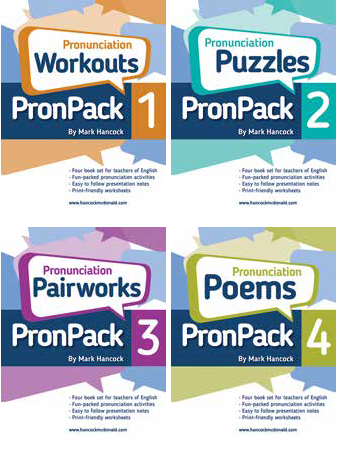PronPack 1-4, Hancock McDonald ELT 2017
Mark Hancock
Hancock McDonald ELT 2017

There are four slim, nicely-produced volumes in Mark Hancock’s latest offering to the world of English language teaching, each dealing with a different aspect of pronunciation practice and awareness-raising.
The books are all around 60 pages and all have sections designed to help busy teachers find their way around quickly and easily. ‘Introduction’ gives an accessible overview of the way each book works, while ‘The Approach’ offers rationales for pronunciation work and necessary explanation of accent variety. ‘The Activities’ explains how the worksheets, lesson plans, audio files and other components work. Every ‘unit’ of each book starts with a section called ‘Background’ which gives a brief but clear underpinning for the activities which follow. There is a brief overview of what can be found on the PronPack website, a list of lesson plans and a ‘Map of the Book’, offering guidance on the minimum level students need to be at for each activity, though, in my view, many of the activities across the range of books could be used as they are, or adapted, for levels other than those specified.
Technical language is kept to a minimum and, where it is essential for clarity, it is explained simply and easily. For example, the alveolar ridge is described by asking the students to run their tongues back from their top teeth to ‘the lump above the teeth’.
All in all, the overview provided is exceptional in content and clarity.
Pronunciation Workouts (Book 1)
Nine pages in this book are devoted to an examination of Mark Hancock’s unique sound chart, its organisation and guide words. Two systems are used, the IPA and American Symbols, with typical spelling and pictures available for both.
Topics such as the post-vocalic ‘r’, word stress and tonic stress are dealt with in fun and interesting ways, using plenty of simple graphics, which provide focus and interest as well as increasing the learners’ awareness.
Care is taken to ensure that speakers using an American accent are catered for with alternative symbols and notes for guidance.
Pronunciation Puzzles (Book 2)
This book contains, as you might expect, pronunciation-based brainteasers. There are activities likely to be attractive to learners of all ages, covering such areas as sound–spelling relationships, tonic stress, connected speech and contrastive stress.
The activities in Unit 2.4 (where the 2 refers to the book and the 4 to the unit in that book) get to grips with the notoriously tricky ‘s’ morpheme; tricky because, at least as a third person present form, it is generally late acquired. An activity using a kind of maze is provided for the students to find their way from the centre via words with a final /ɪz/ (as in wishes) to one of eight exit points. This is challenging and fun, while also giving the students the chance to practise the area in focus, as well as quite a lot of peripheral language.
Pronunciation Pairworks (Book 3)
This book deals with accuracy of production and comprehension, while keeping meaning and intelligibility to the fore.
Five of the 12 units in Pairworks deal with minimal pairs, while the remaining seven units examine aspects of stress and phrasal homophones, or ‘sound bites’ as the author calls them.
Unit 3.9 provides two worksheets, A and B, with the students working in pairs to identify corresponding phrasal homophones. Viewing only Worksheet A, and trying to work out the equivalent in B, kept me amused for a while! Pictures accompany each example, to add interest. Worksheet A contains such challenges as: ‘I lie quite a lot’ and ‘Someone call Dan’ which Worksheet B reveals to be:
‘I like white a lot’ and ‘Someone called Anne’! Good fun and excellent awareness-raising activities.
It is worth noting that many of the activities in all the books contain what the author calls a ‘Flexi’, advising that there are other possible ways to pronounce or deal with an item. For example, Unit 3.4 notes that not all speakers of English use the voiced and unvoiced intradentals (represented by grapheme ‘th’) but replace them with ‘t’ and ‘d’ or ‘f ’ and ‘v’ respectively. Here, too, the author avoids the use of technical language, making the advice accessible to all.
Pronunciation Poems (Book 4)
This, the final book in the series, contains original poems which focus particularly on discrete phonemes in context. Unit 4.12, entitled ‘Kittens and Buttons’, deals with the glottal stop. The teacher’s notes explain that it isn’t obligatory that students pronounce the glottal stop themselves, but they should be able to recognise it.
Other units contain fun and engaging rhymes, chants and lyrics – some of which, musical teachers and students could easily put to music!
Given that pronunciation has often been ignored in English language teaching classrooms, these extremely accessible books offer much to the busy teacher by providing engaging, efficient and effective practice activities to delve into, as and when required.
Many of the units offer ideas for further activities, and also suggestions on which other units can be used to augment the current one. Teacher’s notes in each unit offer clear guidance as well as solutions to the activities where needed. The author goes to great lengths to ensure that the books don’t promote or represent a specific accent, but can be adapted or adjusted as needed.
As a set of books to support teachers and learners, PronPack must be considered a hugely valuable resource.
Steve Hirschhorn
Kismaros, Hungary
Subscribers can get a 12.5% discount on this book. To order and redeem the discount, email info@pavpub.com.
Comments
Write a Comment
Comment Submitted